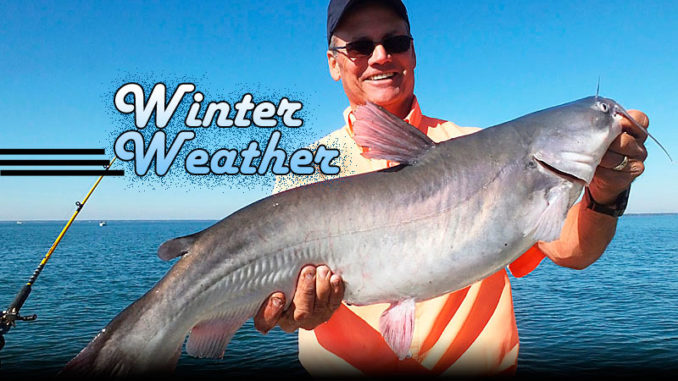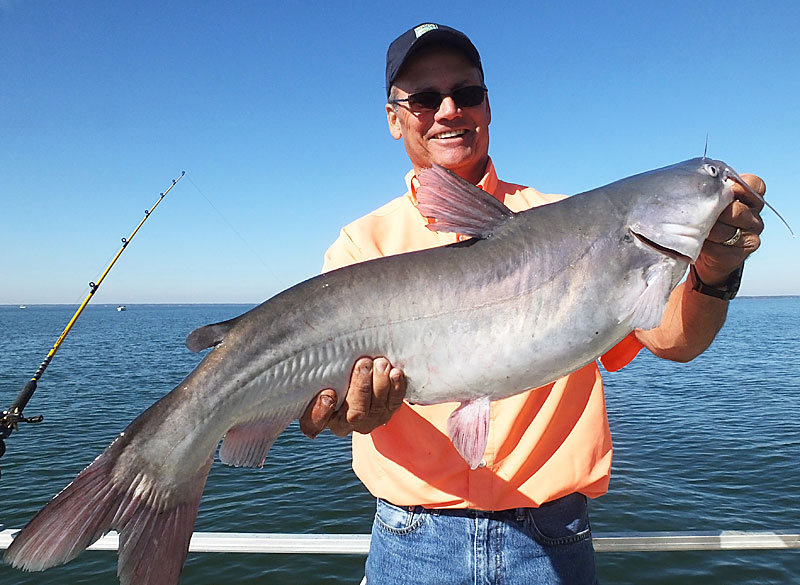
Tough out the weather and you’ll be rewarded
Cold air and water temperatures, combined with a north wind, can make fishing the Santee Cooper lakes uncomfortable and difficult during January. But the reward for toughing it out is excellent fishing for some species.
Forecasting fishing can also be tough. That’s because not all Januaries are created equal. Bitterly cold weather can plunge the water temperature into the low 40s, creating tough fishing for some species — but not for blue catfish. The blues thrive in the cold.
Action will vary from good to sensational in late December through January.
Guide Brett Mitchell said that during warm winters, drift-fishing will continue to be a productive technique as it was through the fall. This technique will provide excellent fishing. But anglers will catch most fish in deeper water.
“Regardless of how the water temperature plays out, the catfish are going to be focused on food,” Mitchell said. “And at this time of the year, the favored forage will be threadfin shad clusters found in both lakes. Find these pods of baitfish, and odds are good blue catfish are nearby feeding on them.”
Mitchell (803-379-7029) said white perch typically feast on the shad. And until the water gets really cold, catfish will eat perch and shad.
“Both lakes produce excellent fishing,” Mitchell said. “On Lake Marion, the lower end of the lake seems best for winter fishing. And on Moultrie, the humps and drops that are near deep water, often 30 to 50 feet, are prime areas to check.”
Baitfish feast
Mitchell uses white perch, herring and shad as his primary baits when drift-fishing. He works channels and ledges in Lake Marion and drift humps and deep holes in Lake Moultrie.

If the water temperature dips into the mid-40s, the scattered pods of shad tend to combine into huge masses. This creates the perfect post-Christmas feast for blue catfish. At this time, anglers can’t beat smaller threadfin shad as the primary bait.
“When the cold water causes the shad to begin to die off, it triggers the blues to key on them as their primary forage,” said Mitchell. He also said that as shad struggle in the cold water, they begin to flutter to the bottom, where voracious blues will be waiting on them. He simulates that reality by dropping multiple shad on a hook to a catfish’s eyeball level.
Fish vertically over schools
“In this scenario, anglers can anchor so the boat sits over the targeted shad schools. You can sit on these places and fish vertically,” he said.
Before fishing, find a school of shad you’re not targeting to fish and catch your bait. One good throw of a cast net should provide all the bait you need for the trip.
Mitchell ties on a circle hook or Eagle Claw live-bait hook with a 1- to 2-ounce sinker about 12 to 18 inches above the hook. He uses at least 30-pound test line and loads the hook with multiple threadfin shad. Then he drops the rig to the depth of the bottom of the baitfish schools on his depth finder.
If the rig bumps the bottom, turn the reel handle about three times and set the rod in a rod holder or keep it in your hand. A hard-charging blue will snatch it into the water if unattended.
When fishing multiple rods, it’s not uncommon to have multiple fish hooked and fish flopping on the bottom of the boat. Sort the mess out, put out more baits and do it again.
Mitchell said this is fun fishing at a very productive time, and anglers can catch plenty of great, eating-sized fish. Big fish are also caught using the same rig.
A warm January when the water temperature doesn’t dip below the low-50s can mean good action on striped bass
 Guide Kevin Davis at Blacks Camp said striper action is best near the deeper water on either lake. He prefers the lower end of Lake Marion and the area near the Pinopolis Dam on Lake Moultrie for consistent action.
Guide Kevin Davis at Blacks Camp said striper action is best near the deeper water on either lake. He prefers the lower end of Lake Marion and the area near the Pinopolis Dam on Lake Moultrie for consistent action.
Davis (843-312-3080) fishes deep water in January because that’s where the primary striper forage is located.
“Several baits can work on stripers with herring, gizzard or threadfin shad all effective,” said Davis, who uses his graph to mark pods of baitfish. Stripers will be marked around them. He lowers the live bait to the level he’s marked fish on the graph and uses multiple rods when drifting live bait.
“If the bait and fish are in a small area, I’ll spot-lock the electric motor on them. If in a wider area I’ll drift over them,” he said. “Some topwater schooling can occur, so keep those rigs handy even in the cold weather.”
Live is no jive:
Live bait will produce some nice striped bass in the Santee Cooper lakes in January in many of the same ways that cut bait produces good catfish action. Locate pods of baitfish and get your baits in front of them, either by drifting or fishing vertically.





Be the first to comment